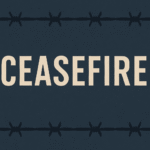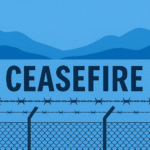Introduction
In an era where artificial intelligence is revolutionizing nearly every aspect of life, its entry into warfare has triggered urgent ethical and legal dilemmas. May 2025, world governments gathered at the United Nations once again to debate the future of autonomous weapons systems—lethal machines that can operate without direct human control. Often referred to as “killer robots,” these systems may soon be able to select, target, and kill without human intervention. The implications are as terrifying as they are real.
At a time when AI is transforming warfare, the international community faces a critical inflection point. Autonomous weapons systems—machines capable of selecting and engaging targets without direct human control—have progressed from theoretical concerns to deployable reality. Despite nearly a decade of diplomatic discussions, the international community has failed to establish binding regulations, even as the technology rapidly advances. This regulatory gap threatens to fundamentally alter the nature of armed conflict, with profound implications for international humanitarian law, ethics, and global security.
The Evolution of Autonomous Weapons: KILLER ROBOTS
Early Precursors (1980s-2000s)
The path to autonomous weapons began decades ago with semi-autonomous systems like the U.S. Navy’s Phalanx Close-In Weapon System, introduced in the 1980s. This defensive system could automatically detect, track, and engage incoming threats, though with limited autonomy and in narrowly defined circumstances. The 1990s saw the introduction of cruise missiles with rudimentary terrain-matching capabilities, allowing for limited autonomous navigation.
By the early 2000s, unmanned aerial vehicles (UAVs) like the Predator and Reaper drones transformed military operations, though they remained under human control for target selection and engagement decisions. These systems represented an important technological bridge—demonstrating the military utility of removing human operators from the battlefield while maintaining human decision-making for lethal force.
The AI Revolution (2010s-Present)
The integration of machine learning and advanced computer vision in the 2010s marked a turning point. Systems began demonstrating increasing abilities to identify, classify, and track potential targets with minimal human input. Military powers invested heavily in autonomous capabilities:
- In 2016, the U.S. Department of Defense’s Strategic Capabilities Office successfully demonstrated autonomous drone swarms that could operate collaboratively with minimal human guidance.
- Russia has developed the Uran-9 unmanned ground vehicle and reportedly deployed it in Syria, though with mixed results.
- China has invested significantly in AI-enhanced military systems, including the Sharp Sword stealth drone and autonomous naval vessels.
- Israel’s Harpy and Harop “loitering munitions” can autonomously patrol areas and attack radar systems without direct human intervention.
What distinguishes today’s systems from earlier precursors is their increasing decision-making sophistication. Modern autonomous weapons employ neural networks that can learn from data and make probabilistic judgments about potential targets. This shift from rule-based to learning-based systems represents a fundamental change in how machines identify and engage combatants.
Current State of Development and Deployment
Technical Capabilities and Limitations
Today’s autonomous weapons systems exist on a spectrum of capabilities:
- Defense Systems: Point-defense systems like the Israeli Iron Dome and South Korean SGR-A1 sentry guns represent the most established autonomous technologies, operating in controlled environments with defined parameters.
- Loitering Munitions: Systems like Turkey’s Kargu-2 drone (reportedly used in Libya) can loiter in an area before selecting and engaging targets with limited human oversight.
- Autonomous Vehicles: Unmanned ground, aerial, and maritime vessels increasingly incorporate autonomous navigation and targeting capabilities, though most still require human authorization for lethal force.
- Swarm Technologies: Perhaps most concerning, collaborative drone swarms can overwhelm defenses through sheer numbers, making meaningful human control practically impossible.
Despite advances, current systems face significant limitations. Computer vision systems remain vulnerable to adversarial examples and environmental factors. Distinguishing between combatants and civilians in complex urban environments exceeds current AI capabilities. Communication vulnerabilities and cyber threats pose additional challenges to reliable operation.
Documented Use Cases
The first documented use of autonomous weapons in conflict occurred during the 2020 Armenia-Azerbaijan war, where loitering munitions reportedly operated with high degrees of autonomy. Turkey’s Kargu-2 drone has been identified by UN experts as capable of autonomous target engagement, marking a watershed moment in the evolution of these technologies.
More recently, the Russia-Ukraine conflict has seen widespread deployment of semi-autonomous systems. The Ukrainian forces’ use of modified commercial drones and the Russian military’s Lancet loitering munitions demonstrate how rapidly these technologies are proliferating across conventional battlefields.
The Regulatory Landscape
International Efforts
International discussions on autonomous weapons began formally in 2014 under the auspices of the UN Convention on Certain Conventional Weapons (CCW). After nearly a decade of deliberations, these talks have yielded minimal concrete results:
- Eleven non-binding “guiding principles” were adopted in 2019, acknowledging the importance of human responsibility but stopping short of meaningful restrictions.
- A Group of Governmental Experts (GGE) has met regularly but remains deadlocked over foundational questions of definitions, scope, and whether binding regulations are needed.
- The 2023-2024 CCW Review Conference produced statements of concern but no enforceable mechanisms.
The diplomatic stalemate stems from fundamental disagreements between major military powers. While 30 countries (including Austria, New Zealand, and Brazil) have explicitly called for a legally binding ban on fully autonomous weapons, the United States, Russia, China, Israel, and other technologically advanced states have opposed such restrictive measures.
National Policies and Strategic Postures
Major powers have adopted divergent approaches to autonomous weapons regulation:
- United States: The Department of Defense’s Directive 3000.09 (updated in 2023) requires “appropriate levels of human judgment” in autonomous systems but permits development of fully autonomous capabilities.
- China: While publicly advocating for restrictions on use, China has invested heavily in military AI research and autonomous systems development.
- Russia: President Putin famously declared that whoever leads in AI “will rule the world,” signaling Russia’s commitment to autonomous military technologies despite rhetorical support for international discussions.
- European Union: The European Parliament has called for a ban on fully autonomous weapons, though individual member states like France have pursued autonomous capabilities.
This divergence in national approaches has created a landscape where rhetoric often contradicts practice, with diplomatic positioning masking accelerating development programs.
Ethical and Legal Considerations
International Humanitarian Law Challenges
Autonomous weapons pose profound challenges to international humanitarian law (IHL), which requires combatants to make nuanced judgments about:
- Distinction: Can AI systems reliably distinguish between combatants and civilians, especially in conflict zones where these lines are often blurred?
- Proportionality: Can machines assess whether expected civilian harm outweighs military advantage in complex, dynamic situations?
- Precaution: Can autonomous systems take feasible precautions to minimize civilian harm while achieving military objectives?
These requirements presuppose human moral judgment and contextual understanding that current AI systems fundamentally lack. While proponents argue that autonomous systems could potentially reduce civilian casualties by removing human emotions like fear and anger from the battlefield, skeptics question whether machines can navigate the moral complexities inherent in warfare.
Accountability Gap
Perhaps most concerning is the “responsibility gap” created by autonomous systems. When a machine makes an independent targeting decision that results in civilian casualties or other IHL violations, determining accountability becomes problematic:
- Programmers may have created the system years before its deployment.
- Military commanders may lack understanding of the system’s decision-making processes.
- Political leaders may be insulated from responsibility through layers of technological complexity.
This diffusion of responsibility threatens to undermine the foundations of international humanitarian law, which assumes identifiable human decision-makers who can be held accountable for their actions.
Strategic Implications
Proliferation Risks
Unlike nuclear weapons, autonomous weapons technology is inherently dual-use and relatively low-cost. The same algorithms powering self-driving cars can be adapted for military purposes. Commercial drones can be weaponized with modest engineering expertise. This accessibility creates unprecedented proliferation challenges:
- Non-state actors, including terrorist organizations, could develop rudimentary autonomous weapons using commercially available components.
- Mid-tier military powers can leverage commercial AI advances to rapidly develop military applications without massive R&D investments.
- The diffusion of knowledge through academic publications, open-source software, and global technical talent makes technological containment nearly impossible.
The democratization of autonomous weapons technology threatens to undermine strategic stability by lowering the barriers to entry for lethal force projection.
Escalation Dynamics
Autonomous weapons introduce novel escalation risks to the international system:
- Speed of Action: Autonomous systems operate at machine speed, potentially compressing decision timelines and reducing opportunities for diplomatic intervention.
- Unpredictability: Complex AI systems may interact in unexpected ways, particularly when opposing autonomous systems encounter each other without human oversight.
- Lowered Threshold for Conflict: By reducing the political cost of military action (no risk to personnel), autonomous weapons may make states more willing to engage in armed conflict.
The combination of speed, unpredictability, and reduced human costs creates a dangerous environment where conflicts could escalate rapidly beyond human control.
The Path Forward
Meaningful Human Control
Despite technological advancement, maintaining meaningful human control over lethal force must remain a core principle. This requires:
- Clear boundaries on what decisions can be delegated to machines.
- Technological safeguards ensuring human oversight of critical targeting decisions.
- Fail-safe mechanisms allowing human intervention in autonomous operations.
“Meaningful human control” differs from simply having a human “in the loop” or “on the loop.” It requires that humans possess sufficient information, time, and ability to exercise judgment over the use of force, even in systems with autonomous capabilities.
Verification and Transparency
Any effective regulatory regime must include verification mechanisms:
- Technical standards for autonomous systems certification.
- International inspection protocols for deployed systems.
- Transparency requirements for development programs.
Unlike nuclear weapons, which can be counted and monitored through satellite imagery, autonomous capabilities are largely intangible—residing in software and algorithms. This presents novel verification challenges requiring innovative approaches to transparency and trust-building.
Multi-stakeholder Approach
Progress requires engagement beyond traditional state actors:
- Technical Community: AI researchers and roboticists must integrate ethical considerations into design processes.
- Private Sector: Companies developing dual-use AI technologies must adopt robust ethical guidelines and responsible innovation practices.
- Civil Society: Organizations like the Campaign to Stop Killer Robots and the International Committee of the Red Cross play crucial roles in maintaining pressure for regulation.
The complexity of autonomous weapons governance requires this multi-layered approach, leveraging expertise and influence across sectors.
Conclusion
The regulation of autonomous weapons represents one of the most significant arms control challenges of the 21st century. Unlike previous weapons technologies, autonomous systems blur the line between tool and decision-maker, raising fundamental questions about human agency in warfare. The technology’s rapid evolution, combined with its accessibility and dual-use nature, creates urgent imperatives for action.
While diplomatic progress has been frustratingly slow, the stakes demand persistence. The international community must overcome political obstacles to establish meaningful controls before fully autonomous weapons become normalized in conflict. The alternative—a world where algorithms make life-and-death decisions on the battlefield—would represent a profound moral regression and a dangerous new chapter in the history of warfare.
The time for decisive action is now. Whether through the CCW, a new purpose-built treaty, or a coalition of willing states, the international community must establish red lines that preserve human dignity and responsibility in armed conflict. Future generations will judge us by our response to this pivotal technological moment.





